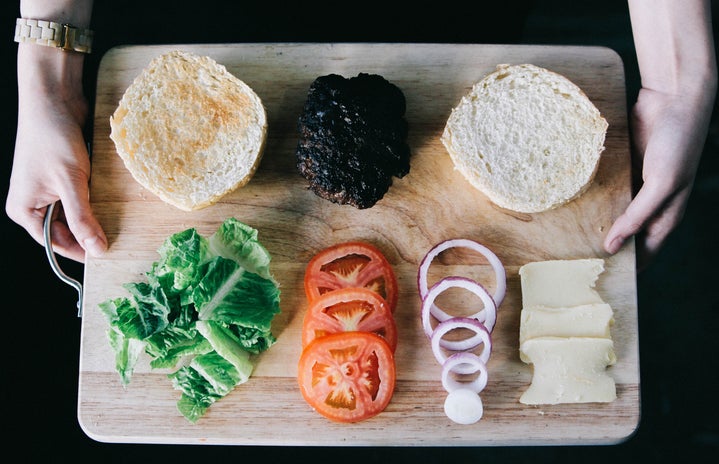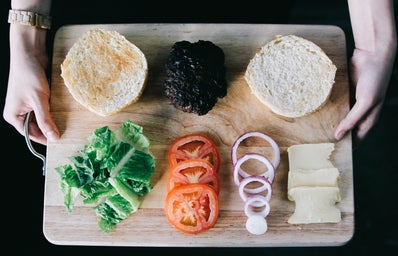Since the beginning of mankind, we have become dependent on animal products as a food source. As population increased, so did the production of animal agriculture and its profitability. Unfortunately, it has grown into an industry that is unsustainable for this planet and is demolishing our environment at an astonishing rate. In the academic article, “‘Cowspiracy’ Strips the Meat Industry Down to the Bone”, Ford reports the shocking statistic that “even if all utilities were turned off and every fossil-fuel-guzzling system of transportation ceased immediately, environmental damage that results from greenhouse gases would be irreversible…even with humanity’s greatest efforts, the dairy and meat industries will still eventually destroy life on Earth”. As the environment is at its most devastating point, the major contribution that animal agriculture has on rainforest deforestation, pollution of our water, and global warming becomes undeniable.
Scientists have proven that global climate change is a direct result of mankind and is not in fact caused by natural occurrences. In addition, Walsh agrees with recent studies that the raising of livestock might be the biggest impact humans have on the planet today. Nonetheless, this impact is nothing to be proud of when animal agriculture takes up 40 percent of our earth’s land alone, is the cause of the world’s methane emissions by up to 40 percent, and is an industry that consumes excessive amounts of our fresh water (McWilliams 30). Did you know that it takes 2,500 gallons of water to produce just 1 pound of beef (McCarthy 29)? Henning states, that each year 56 billion animals are slaughtered due to livestock production and that this is an average of 650 animals killed every single second (64). Animal agriculture is a system of supply and demand, so by purchasing any animal products you are ultimately harming our planet. The question on whether animal agriculture is causing irreversible damage to our planet has become undeniable and irrational to ignore with the heavy amount of consistent and well conducted research (McCarthy 29).
Animal agriculture is one of the major causes of rainforest deforestation, which is an environmental pressing issue. In the academic journal, Standing In Livestock’s ‘Long Shadow’, Henning declares that the human population isn’t far behind in growing to an estimate of nine billion people. With this, the demand for animal products increases and this is the driving force behind what is known as “land conversion” (72). In other words, as the demand for more agricultural production increases, the more land it takes over. Henning notes, that to compensate for the growing rate of meat production, about a third of the Earth’s land has been cleared for global farms (72). With this, researchers say that in a hundred years, rainforests could completely vanish due to rainforest clearing (Garlow). Garlow and Henning both agree that meat production is the greatest driving force to rainforest deforestation (72). Today, livestock is accountable for up to 97 percent of the Brazilian Amazon destruction and it doesn’t stop there (McCarthy 29). At this moment, the greatest deforestation is occurring in Latin America and at the same time, 70 percent of their land is occupied by pastures that was once covered by forest (Henning 72). Consequently, we are facing another environmental problem of animal extinctions due to the fact that rainforests are home to thousands of plants and animals that need sustain of the land (Garlow). Furthermore, Henning illustrates, the growth of pasture land is currently on the rise once again and has reached an annual rate of more than 32 million acres a year; all of this land was once covered by forest. This is equivalent to the size of Greece or Nicaragua being deforested every year (72). On the other hand, even with these well conducted statistics organizations argue that deforestation is a result of urban expansion caused by human population growth, but in fact this is only a tiny contributor compared to animal agriculture (Garlow). Not only has animal production led to deforestation, but as a direct result, all crop land in the U.S. is being depleted thirteen times faster than its replenish rate due to “mostly overgrazing, compaction and erosion” and ultimately causing desertification (Henning 70). So, what once was a region thriving off of rainforest land is now merely a desert where life is unsustainable for those who once lived there. All in all, rainforest deforestation caused by animal agriculture is ultimately severe and irreversible.
Another major impact animal agriculture has on our environment is the consumption and pollution of our Earth’s water supply. In the article, The Triple Whopper Environmental Impact of Global Meat Production, Walsh asserts that animal agriculture uses up one third of the world’s fresh water supply. To further understand, “almost 900 gallons of water are needed to produce 1 pound of cheese, 477 gallons for a pound of eggs, and 2500 gallons for 1 pound of beef” (McCarthy 29). Under these circumstances, our water input is much greater than our output and this is going to have many consequences. If one third of our fresh water is consumed by livestock, then the amount of fresh water left to be directly consumed and used for utilities by the world’s growing population is becoming scarce. Henning expresses that in many parts of the world, the replenishment rate of fresh water is well below its usage. An even more devastating statistic is that worldwide only “one in six people do not have access to fresh water and more than twice that number…lack access to adequate sanitation facilities” (69). For those who are lucky enough to live in wealthy nations and are not affected by the shortage, scarcity, and the depletion of freshwater, rarely understand the damage being done by raising livestock and may not until it’s already too late. It’s estimated that 64 percent of the world’s population will live in a “water stressed” basin by the year 2025 (Henning 70) Currently, droughts are already a major problem caused by livestock raising. For instance, Grass-fed cattle require more water than California’s most water-intensive crop, alfalfa (Fairlie and McWilliams 30). The problem with animal agriculture isn’t just the consumption of our freshwater supply, but the pollution as well. In the United States, livestock produces ten times more waste than humans and that waste isn’t cleaned, but instead dumped and collected in vast lagoons that repeatedly leak into waterways and aquifers (Henning 70). Just as a livestock’s’ feces and manure pollute water, agricultural methods are also responsible for pesticides and fertilizers that runoff into waterways, ultimately polluting fresh water and weakening an already stressed marine ecosystem. Furthermore, the FAO finds that livestock production plays a large role in the degradation of our ocean’s coral reefs and ‘dead’ zones in coastal areas (Henning 71). As can be seen, animal agriculture affects our water in more ways than one. Not only are these methods impacting our limited fresh water supply, but they are also resulting in the death of many important ecosystems that soon won’t exist unless change happens.
Lastly, many of the impacts animal agriculture has had on our planet has led to global climate change. Just animal agriculture alone, accounts for 18% of all greenhouse gas emissions and this impact is more than all transportation combined. (McCarthy 29) In other words, “the food we eat contributes more to global climate change than what we drive or the energy we use” (Henning 73). Walsh emphasizes that the meat industry believes this estimate is too high, whereas environmentalist believe the estimate is way below what it should be. McWilliams points out that livestock currently accounts for 40% of methane emissions, which is 23 times more powerful than the greenhouse gas carbon (Fairlie and McWilliams 30). Moreover, methane is a significant contributor to global climate change, as it contributes to 21 percent of all warming (Henning 74). Additionally, deforestation from animal agriculture also plays a role in more greenhouse gases in our air. Walsh explains, “that cattle in countries like Ethiopia and Somalia account for as much as 1,000 kg of carbon for every kg of protein they produce” and this comes from manure in the form of methane and is also a result of forest that were converted to pastures that no longer absorb carbon to reduce the output put in the air. Overall, the impact animal agriculture has on climate change will lead to a future, that has already begun with “melting icecaps and glaciers, rising sea levels, shifting weather patterns, more intense storms, drought, desertification, species extinction, salinization of freshwater, spread of infectious disease and millions of environmental refugees” (Henning 75).
All in all, animal agriculture has a significant impact on our environment by largely contributing to rainforest deforestation, water consumption and pollution, and greenhouse gas emissions. These effects are going to have devastating results for mankind and our ecosystems and they are closely approaching in the near future. It’s clear that the products and foods that we buy are directly supporting animal agriculture industries and their practices that are destroying our planet. Multiple health associations agree that living without the use of animal agriculture is easily accessible (Garlow). Whereas, living without our forests, water supply, and causing global climate change is not as simple.
HCXO, Cailee
Sources:
Fairlie, Simon, and James McWilliams. “Can Eating Meat and Dairy Products Be Sustainable?” 1 June 2015. http://eds.a.ebscohost.com.proxy.hvcc.edu:2048/eds/pdfviewer/pdfviewer?sid=31c0b438-fe9c-45a8-8119-29dcdfa0455a%40sessionmgr4006&vid=3&hid=4202
Ford, Chandler. “’Cowspiracy’ Strips the Meat Industry Down to the Bone.” ‘Cowspiracy’ Strips the Meat Industry Down to the Bone, 25 Sept. 2016, p. 1. Galegroup, go.galegroup.com.proxy.hvcc.edu:2048/ps/i.do?p=AONE&u=hvcc&id=GALE|A464627047&v=2.1&it=r&sid=ebsco&userGroup=hvcc&authCount=1.
Garlow, Ariel. “This Is How Animal Agriculture Causes Deforestation.” One Green Planet, One Green Planet, 5 June 2014, www.onegreenplanet.org/animalsandnature/this-is-how-animal-agriculture-causes-deforestation/.
This is How Animal Agriculture Causes Deforestation – One …
There’s really one thing you and everyone else can’t live without, and that’s trees!
Henning, Brian G. “Standing in Livestock’s ‘Long Shadow’: The Ethics of Eating Meat on a Small Planet.” Ethics and the Environment, vol. 16, no. 2, 2011, pp. 63–93. JSTOR, www.jstor.org/stable/10.2979/ethicsenviro.16.2.63?ref=search-gateway:0d078833895d211fe336963ecb14c53b.
Created Date: 10/20/2011 7:05:23 PM
McCarthy, Colman. “Are You Willing to Change Your Diet?” National Catholic Reporter, 3 July 2015, p. 29. Academic OneFile [Gale], eds.a.ebscohost.com.proxy.hvcc.edu:2048/eds/pdfviewer/pdfviewer?sid=31c0b438-fe9c-45a8-8119-29dcdfa0455a%40sessionmgr4006&vid=9&hid=4202.
Walsh, Bryan. “The Triple Whopper Environmental Impact of Global Meat Production.” Time, Time, 16 Dec. 2013, science.time.com/2013/12/16/the-triple-whopper-environmental-impact-of-global-meat-production/.
*Disclaimer: The views expressed in this article do not reflect the views of Her Campus Oneonta*



